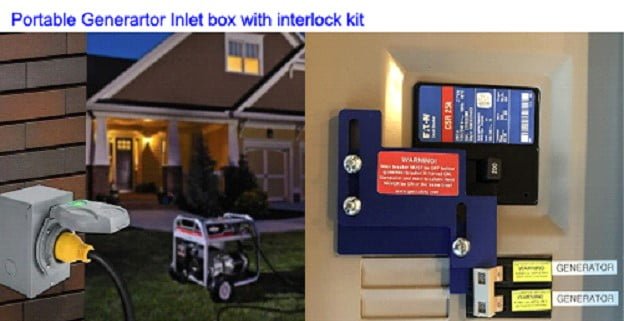Portable Backup Generator Installation
A fully automatic standby portable generator normally can cost between $20K to $30K which is typically beyond most residential home owner’s budgets. A much more viable option for residential homeowners is a portable generator for emergency backup power.
A residential portable generator can be a lifesaver during power outages caused by natural disasters, storms, or other emergencies. It can help keep your home and family safe and comfortable by providing backup power to essential appliances such as heating systems, air conditioning, sump pumps, WiFi, and other necessities
1. Interlock Kit on Electrical Panel with Generator Outlet.

This setup cost is around $800 (excluding the cost of the generator and the power cord). NSW Electrical will install an interlock kit on your circuit panel to prevent power back-feeding the power from the generator to the utility company. We will also install a 30-amp or 50-amp generator inlet box on the opposite side of the circuit panel ( Outside the house). You will roll your generator out and plug it into this inlet box when you lose power. Then the generator feeds power to the whole Electrical panel. You can choose between utility power or backup generator power. This setup is manual, simple, and costs much less than a permanent integrated backup generator. The advantage of a temporary portable generator is its low-cost setup, and flexibility to change circuits around. ( Ex: Turn off the AC circuit and use the dryer, then switch back to AC). It will include the start-up generator, testing, and a walk-through with customers to explain the system operation fully.
The Disadvantage of this setup is that you need to manually turn the main breaker on and off when you switch the power back to the main line or the generator. We will do a start-up test, and train our customers how the system operates to make sure they know how to configure things when they need to use the portable generator after installation.

2. Transfer Switch with Generator Inlet Box.
The advantage of this setup is you can save time and hassles by not needing to think about what you need to turn on and turn off. Especially if you have power outages frequently. This setup is less work and less confusing for most customers.
The disadvantage is we have to pre-wire which circuits that you want to be on during an emergency( around 5 to 6), and you won’t be able to switch those circuits around. For example, you won’t be able to turn off the AC circuit and swap it for a microwave or dryer/washer circuit. So with this setup there is less flexibility, but this is great for people who don’t know anything about electricity and want minimal work with peace of mind.
3. 50 Amp 25 ft Power Cord
You will just need a 50 amp power cord like this and a generator

4. Here’s a good choice of a Portable Generator:

Let us know if you have any other questions. We will be happy to Portable Generator Installation options with you in more detail!

